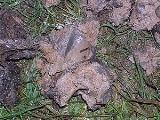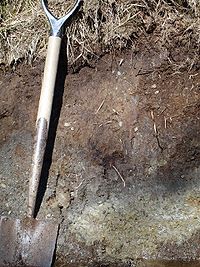
Gley soil
Encyclopedia

Soil science
Soil science is the study of soil as a natural resource on the surface of the earth including soil formation, classification and mapping; physical, chemical, biological, and fertility properties of soils; and these properties in relation to the use and management of soils.Sometimes terms which...
is a type of hydric soil
Hydric soil
A hydric soil is a soil that formed under conditions of saturation, flooding, or ponding long enough during the growing season to develop anaerobic conditions in the upper part....
which exhibits a greenish-blue-grey soil color
Soil color
Soil colour does not affect the behavior and use of soil, however it can indicate the composition of the soil and give clues to the conditions that the soil is subjected to....
due to wetland
Wetland
A wetland is an area of land whose soil is saturated with water either permanently or seasonally. Wetlands are categorised by their characteristic vegetation, which is adapted to these unique soil conditions....
conditions. On exposure to the air, gley colors are transformed to a mottled pattern of reddish, yellow or orange patches. During gley soil formation (a process known as gleying), the oxygen
Oxygen
Oxygen is the element with atomic number 8 and represented by the symbol O. Its name derives from the Greek roots ὀξύς and -γενής , because at the time of naming, it was mistakenly thought that all acids required oxygen in their composition...
supply in the soil profile is restricted due to soil moisture at saturation. Anaerobic
Anaerobic organism
An anaerobic organism or anaerobe is any organism that does not require oxygen for growth. It could possibly react negatively and may even die if oxygen is present...
micro-organisms support cellular respiration
Cellular respiration
Cellular respiration is the set of the metabolic reactions and processes that take place in the cells of organisms to convert biochemical energy from nutrients into adenosine triphosphate , and then release waste products. The reactions involved in respiration are catabolic reactions that involve...
by using alternatives to free oxygen as electron acceptors. This is most often the case when the sesquioxide
Sesquioxide
A sesquioxide is an oxide containing three atoms of oxygen with two atoms of another element. For example, aluminium oxide is a sesquioxide.Many sesquioxides contain the metal in the +3 oxidation state and the oxide ion, e.g., Al2O3, La2O3...
of iron
Iron
Iron is a chemical element with the symbol Fe and atomic number 26. It is a metal in the first transition series. It is the most common element forming the planet Earth as a whole, forming much of Earth's outer and inner core. It is the fourth most common element in the Earth's crust...
, ferric oxide is reduced
Redox
Redox reactions describe all chemical reactions in which atoms have their oxidation state changed....
to ferrous oxide by the removal of oxygen. These reduced mineral compounds produce the gley soil typical color. Green rust, a layered double hydroxide (LDH
LDH
LDH is an acronym which may refer to:* Lactate dehydrogenase, an enzyme in a wide range of plants, animals and other organisms; is measured as part of the complete blood test* Large diameter hose, a type of fire hose...
) of Fe(II) and Fe(III) can be found as the mineral fougerite
Fougerite
Fougerite is a recently discovered representative of clay minerals, chemically and structurally related to so-called green rust, hydrotalcite-like minerals and other layered double hydroxides. The formula of the mineral is complex due to structural variabilities, as is for green rust, thus...
in gley soils.
Gley soils may be sticky and hard to work, especially where the gleying is caused by surface water, held up on a slowly permeable layer. However, some ground-water gley soils have permeable
Permeability (fluid)
Permeability in fluid mechanics and the earth sciences is a measure of the ability of a porous material to allow fluids to pass through it.- Units :...
lower horizons, including some sands, for example in hollows within sand dune systems, known as slacks, and in some alluvial situations.
Groundwater gley soils develop where drainage
Drainage
Drainage is the natural or artificial removal of surface and sub-surface water from an area. Many agricultural soils need drainage to improve production or to manage water supplies.-Early history:...
is poor because the water table
Water table
The water table is the level at which the submarine pressure is far from atmospheric pressure. It may be conveniently visualized as the 'surface' of the subsurface materials that are saturated with groundwater in a given vicinity. However, saturated conditions may extend above the water table as...
(phreatic
Phreatic
The term phreatic is used in Earth sciences to refer to matters relating to ground water below the water table . The term 'phreatic surface' indicates the location where the pore water pressure is under atmospheric conditions...
surface) is high, whilst Surface-water gleying occurs when precipitation
Precipitation (meteorology)
In meteorology, precipitation In meteorology, precipitation In meteorology, precipitation (also known as one of the classes of hydrometeors, which are atmospheric water phenomena is any product of the condensation of atmospheric water vapor that falls under gravity. The main forms of precipitation...
inputs at the surface do not drain freely through the ground. A reducing environment exists in the saturated layers, which become mottled greyish-blue or brown because of the content of ferrous iron and organic matter. The presence of reddish or orange mottles indicates localised re-oxidation of ferrous salts in the soil matrix, and is often associated with root channels, animal burrows or cracking of the soil material during dry spells.

Classification
Most soil classificationSoil classification
Soil classification deals with the systematic categorization of soils based on distinguishing characteristics as well as criteria that dictate choices in use.- Overview :...
s divide the gley soils into surface-water gleys (also known as stagnogleys) and gleys proper, or groundwater gleys, the former having a slowly pemeable lower subsoil, leading to a "perched" water table, the latter being in low ground or basin situations where the natural groundwater table is constantly high enough to influence the soil profile.
Gley soil is grouped under Gleysols
Gleysols
A Gleysol in the FAO World Reference Base for Soil Resources is a wetland soil that, unless drained, is saturated with groundwater for long enough periods to develop a characteristic gleyic colour pattern...
in the FAO
Fão
Fão is a town in Esposende Municipality in Portugal....
World Reference Base for Soil Resources
World Reference Base for Soil Resources
The World Reference Base for Soil Resources is the international standard taxonomic soil classification system endorsed by the International Union of Soil Sciences . It was developed by an international collaboration coordinated by the International Soil Reference and Information Centre and...
.
See also
- Anaerobic respirationAnaerobic respirationAnaerobic respiration is a form of respiration using electron acceptors other than oxygen. Although oxygen is not used as the final electron acceptor, the process still uses a respiratory electron transport chain; it is respiration without oxygen...
- FougeriteFougeriteFougerite is a recently discovered representative of clay minerals, chemically and structurally related to so-called green rust, hydrotalcite-like minerals and other layered double hydroxides. The formula of the mineral is complex due to structural variabilities, as is for green rust, thus...
, the natural form of green rust - RedoxRedoxRedox reactions describe all chemical reactions in which atoms have their oxidation state changed....

